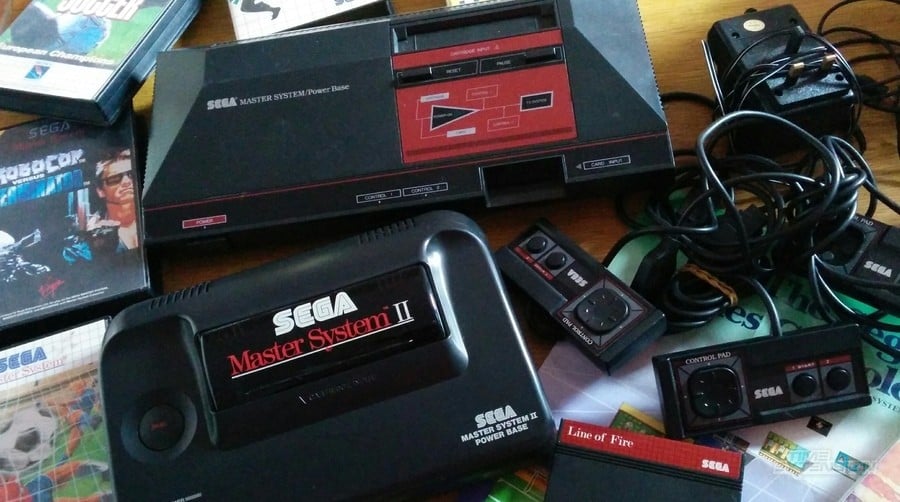
As you may be aware, recently we spoke to the former vice president of sales at Nintendo of America, Bruce Lowry, about what it was like launching the NES in the States, his time at Sega, and his reasons for returning to Nintendo to help the company try to better establish its position in Europe.
As part of our chat, Lowry was kind enough to share some of the details about what it was like preparing to launch Sega's Master System console against the NES in 1986, revealing an interesting story in the process about how the console first got its name.
"Master System was [...] the better system," Lowry told us. "But when we sat down, I told them, 'You've got to redesign it.' I was over there for like a month in Japan, and we went through all these different designs, everything to get it to compete against Nintendo, and my marketing guy, Bob Harris, also came up with its new name, the Master System."
He continued, "I remember I was in Japan with Bob and [Isao] Okawa, who was the Sega chairman and a very wealthy individual, met us at a hotel. Anyhow, he asked us, 'Why did you call it a Master System?' Well, Bob had done martial arts for a long time, and he just said, 'In martial arts, you always want to achieve being the master.' Okawa bowed and replied through his translator, 'Very smart!'"
Interestingly, this story seems to be a somewhat truncated version of an anecdote Lowry has previously given to other historians and reporters in the past, which saw Lowry and Harris meeting Sega President Hayao Nakayama and Sega chairman Isao Okawa at the Imperial Hotel in Tokyo. In these other retellings, however, there are some noticeable deviations and omissions from the version Lowry gave us, which are definitely worth noting for transparency.
First off is the difference in who came up with the name, with Lowry, not Harris, previously being credited in Ken Horowitz's book Playing at the Next Level (based on Lowry's own account), while in a July 2002 issue of Game Informer, the Sega of America founder attributes it to an unspecified group of people at Sega.
Arguably more important than that, though, is the actual reason given for why the name was picked, with the story Lowry gave us missing a key piece of context
As recounted in Horowitz's book and the Game Informer piece, Lowry told the interviewers that the Sega Master System wasn't actually named because of Harris's experience with martial arts, as indicated above, with that reason instead simply being a clever ad-lib from Harris on the spur of the moment.
A passage from Horowitz's book, for instance, reads:
"Okawa, who only spoke Japanese, turned to Harris and sternly asked why that name had been selected. Harris froze as the query was translated for him, and according to Lowry, a deathly silence filled the room. Harris glanced over once at Lowry and proceeded to ad lib a reason. He explained that similar to how one is declared a master of the martial arts only after demonstrating superiority over all opponents, Sega must demonstrate that its console was superior over the competition."
Instead, the true reason was much more random, with Lowry telling Game Informer in the 2002 interview that the name simply came out of a brainstorming session at Sega of America, where they were throwing darts at the wall:
"We had to come up with what we were going to call it, and nobody could figure out what to [name it]. We came up with this idea that we were going to call it the Sega Master System. It sounded as good as anything else we had on the board. We had a white marker board with a bunch of names up there and we had these rubber darts we threw at it, and whichever one stuck, that was the name we were going to give it. So, Master System kept coming up and it sounded pretty good."
As Lowry told Game Informer, they were too nervous to tell Okawa the reason, figuring "throwing darts at the whiteboard" was not the answer Okawa wanted to hear, so they made up the martial arts story as a more meaningful cover to impress the Sega Chairman.
Another slight wrinkle to the story we also want to address is that, while Lowry was at the company, the Sega Master System name wasn't actually the name of the main unit itself in North America, but originally appears to have been the name used specifically to market the launch bundle of the console (which came with the Sega Light Phaser).
As the website Sega Retro highlights, it was only later that it eventually became the console's de facto name, due to the bundle being the most prominent version of the console on the market, and the version demonstrated to the press and in marketing. This likely explains why Lowry counts it as the main version of the console he brought to market.
